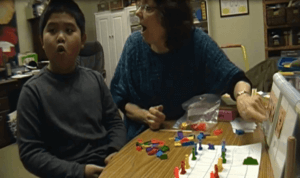Blog
From Silence to Sound-Part 2
Hank’s Continued Story
Neurofeedback Increased Alertness but Not Verbal Skills
He returned to see me after eighteen months with increased engagement in the treatment process, but he still could not imitate any sounds. Since he was now able to imitate specific static positions, I used these to activate certain areas of the brain to improve mirror neurons needed for speech imitation. Hank was now able to begin using the Interactive Metronome to increase neurological sequencing and timing with a focus on a predictable rhythm and imitating drum rhythms to tune into variable rhythms. I have found rhythms are a key component to social engagement and often improve speech production. https://www.ctsdallas.com/resources/recommended-reading/See Autism Spot videos of Jane #3.
Hank Begins Communicating with iPad App
One day, mom reported that Hank had started making consonant sounds that he was using to gain her attention. He had also been taught to use an augmentative communication device at school. I recommended switching from the cumbersome one he had at school to the simpler and more compact iPad application that he could also use at home. He quickly learned that everything had a name and that naming things gave him power. He soon was able to create his own requests in sentences with picture cues on this device which increased his awareness and motivation to communicate with others.

Each new skill brought Hank closer to verbal communication. After significant tactile cueing in one session, Hank was able to lower his tongue to make the first “speech-like” vowel sound he had ever produced. His focus on his mouth movements increased by watching my mouth comparing it to his mouth while making sounds looking into mirrors. He also looked at mouth forms and facial expression pictures and attempted to imitate the facial expressions. This was initially very challenging, but within two weeks he got better at the simpler expressions. The better he was at imitating facial expressions the better he became at imitating sounds both consonants and vowels, but he was still not combining them into words. Hank took another break from therapy due to personal reasons. When he returned 3 months later, he was using the consonant /m/ to gain his mother’s attention. He was shrieking the open vowel /u/ for random vocalizations but using the first speech sounding /a/ to specify specific object requests. He was now on the verge of being a verbal communicator.
Hank Starts to Vocalize Speech Sounds!
Each new skill brought Hank closer to verbal communication. After significant tactile cueing in one session, Hank was able to lower his tongue to make the first “speech-like” vowel sound he had ever produced. His focus on his mouth movements increased by watching my mouth comparing it to his mouth while making sounds looking into mirrors. He also looked at mouth forms and facial expression pictures and attempted to imitate the facial expressions. This was initially very challenging, but within two weeks he got better at the simpler expressions. The better he was at imitating facial expressions the better he became at imitating sounds both consonants and vowels, but he was still not combining them into words. Hank took another break from therapy due to personal reasons. When he returned 3 months later, he was using the consonant /m/ to gain his mother’s attention. He was shrieking the open vowel /u/ for random vocalizations but using the first speech sounding /a/ to specify specific object requests. He was now on the verge of being a verbal communicator.
